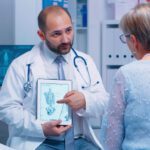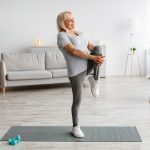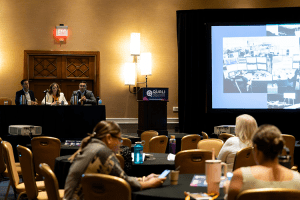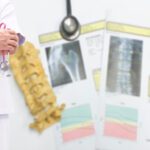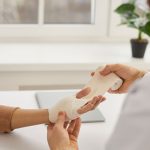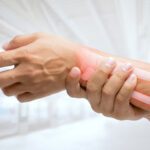Osteoporosis is a silent disease that often goes unnoticed until a bone fracture occurs. It is a medical condition that affects bone density, making bones fragile and brittle and prone to fracture. Osteoporosis can be a debilitating disease and can lead to long-term disability and even death. According to the International Osteoporosis Foundation, about 200 million people worldwide suffer from osteoporosis, with 1 in 3 women and 1 in 5 men over the age of 50 experiencing fractures due to osteoporosis.
What Are the Screening Recommendations?
To combat the prevalence of osteoporosis, the United States Preventive Services Task Force (USPSTF) released recommendations for bone measurement testing to screen women aged 65 or older and postmenopausal women younger than 65 who are at increased risk of osteoporosis. The USPSTF recommends bone measurement testing to determine the risk of fracture. The recommendations align with the National Osteoporosis Foundation’s (NOF) clinical practice guidelines, which emphasize the importance of early identification of individuals at risk for osteoporosis. Screening provides an opportunity for healthcare providers to identify patients at risk for osteoporosis and initiate early interventions to prevent fractures.
Clinical Quality Reporting Requirements Include Two Osteoporosis Screening Measures
HEDIS®, short for Healthcare Effectiveness Data and Information Set, refers to a broadly used set of quality measures in the health care industry. Over 90 percent of health plans rely on HEDIS to measure performance. HEDIS allows consumers and purchasers to compare health plans to each other and to national or regional benchmarks. HEDIS is managed by the National Committee for Quality Assurance (NCQA), a private, non-profit organization that accredits and certifies health care organizations.
In line with the USPSTF recommendation, NCQA introduced the Osteoporosis Screening in Older Women (OSW) measure in HEDIS® MY 2020. In contrast with the Osteoporosis Management in Women who had a Fracture (OMW) measure, which focuses on screening and intervention AFTER a woman fractures a bone, the OSW measure assesses the percentage of women 65–75 years of age who ever received osteoporosis screening between their 65th birthday and the end of the current measurement year. Plans with a Medicare Advantage contract and NCQA-accredited plans must report both the OMW and the OSW measures each year as part of their clinical quality reporting requirements. The higher the rates, the better the performance. The reported performance on these and other measures affects the plans’ quality ratings.
Health Plans and Providers Rely on Portable Bone Density Scanners to Improve Rates and Outcomes
Because they present a good opportunity to improve both OMW and OSW rates by increasing accessibility and convenience, portable bone density scanners are a great tool to incorporate into any quality improvement strategy. Portable devices use ultrasound technology to measure bone density at the wrist, providing a quick and convenient alternative to DXA scans. These devices can be used in community-based settings, such as senior centers or primary care offices, to increase accessibility and convenience for patients.
A study conducted in a community-based setting found that portable ultrasound devices were effective in identifying individuals with low bone density who were at risk of osteoporosis. The study found that 88% of the participants found the portable device more convenient than a DXA scan, and 80% preferred to have follow-up testing with the portable device. Another study found that the use of a portable ultrasound device increased the number of patients who were screened for osteoporosis by 50%. The study also found that the use of a portable device increased patient adherence to follow-up testing by 74%.
Health plans and medical practices that have adopted and expanded the use of portable bone density scanners have been successful not only in improving OMW and OSW rates but also in increasing patient adherence to follow-up testing, ultimately preventing fractures and the complications associated with osteoporosis.
References:
International Osteoporosis Foundation. Facts and Statistics. https://www.osteoporosis.foundation/facts-statistics
U.S. Preventive Services Task Force. Screening for Osteoporosis to Prevent Fractures: US Preventive Services Task Force Recommendation Statement. JAMA. 2018;319(24):2521–2531. doi:10.1001/jama.2018.7498
National Osteoporosis Foundation. Clinician’s Guide to Prevention and Treatment of Osteoporosis. https://cdn.nof.org/wp-content/uploads/2016/02/NOF_Clinicians_Guide-508.pdf
Bachmann KN, Chang G, Lado F, Lewis J, Encarnacion M, Kulas JF. Feasibility of Community-Based Screening for Osteoporosis Using a Portable Ultrasound Device. J Am Geriatr Soc. 2015;63(3):562-566. doi:10.1111/jgs.13301
Bonnick SL, Harris ST, Kendler DL, et al. Comparison of heel quantitative ultrasound and dual-energy X-ray absorptiometry for the diagnosis of osteoporosis in postmenopausal women. J Clin Densitom. 2006;9(3):267-274. doi:10.1016/j.jocd.2006.03.010
Natzke BM, Welch WA, Byrne KM, et al. Osteoporosis screening in postmenopausal women using a portable ultrasound device: correlation with quantitative computed tomography. J Clin Densitom. 2005;8(4):414-420. doi:10.1385/JCD:8:4:414







